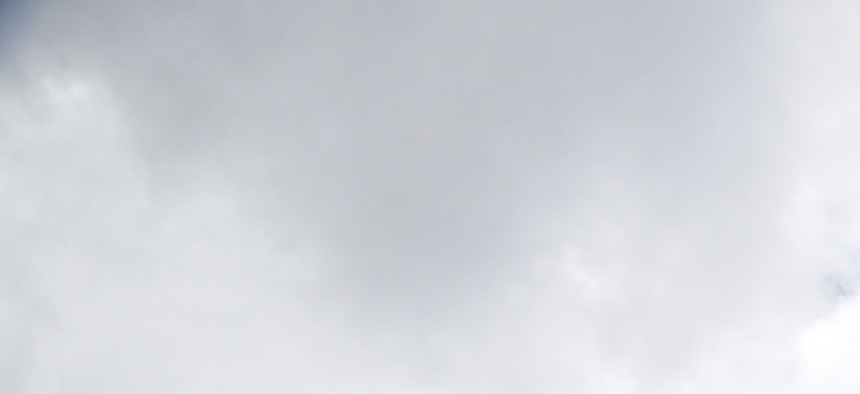
A photo of a guard tower at the entrance to the Camp VI facility at Guantanamo Bay Naval Base, taken on November 19, 2013. Charles Dharapak/AP
How the Pentagon Can Track the Taliban 5
The Taliban 5 may disappear back into the fight, but that doesn’t mean they aren’t findable. By Patrick Tucker
Critics on Capitol Hill and across the country have called the swap of five Taliban prisoners for one American soldier a bad bargain. The alleged terrorist leaders released from Guantanamo Bay (first to Qatar but eventually back to Afghanistan) could disappear back into the fight and kill American forces and civilians. But researchers say not to worry, big data and a formula that predicts terrorists' movements gives the U.S. the ability to forecast some of the key places where the dangerous former detainees would go next.
A recent intelligence assessment on the individuals, first broken by the Daily Beast, found that intelligence pros expect at least four of the five to return to the battlefield. Secretary of State John Kerry has said that they may face a targeted drone strikes in the event that they take up arms. But how to track where they go from Qatar?
Researchers today can outfit endangered animals or research subjects with GPS and radio trackers, an obvious solution to tracking down prey that doesn’t want to be found. But topography can disrupt the way radio transmitters work and these devices also require plenty of power to broadcast long distances, in the form of a cumbersome (and often hot) battery. That is why when researchers use them in the wild these devices usually take the form of conspicuous collars. Additionally, surgically implanting trackers in detained prisoners isn’t a practice that U.S. admits to.
That leaves math, data, and statistics as the best solution for finding the Taliban 5. Modeling the behavior of a former detainee like Mullah Mohammad Fazl on a mountain in Pakistan is no small problem. One of the few truly qualified to stab at it is VS Subrahmanian, a computer science professor at the University of Maryland. Subrahmanian has a lot of experience in the very difficult task of building computer models to anticipate terrorist movements. In the book Computational Analysis of Terrorist Groups: Lashkar-e-Taiba, he and fellow researchers used a big data analysis to predict the behavior of the Lashkar-e-Taiba and Indian Mujahideen terrorist groups. Their model correctly forecast attacks in October 2013 on the life of Indian Prime Ministerial Candidate Narendra Modi’s rally in Patna, India. They have applied it successfully to finding weapons caches in Iraq and Afghanistan, and to track movements by Hezbollah.
“It works like a beacon,” he said. “When the condition is lit or not lit, you have a good understanding of whether or not the attack would occur in the next few months. You want to see if multiple of these conditions are turned on. If they are lit then you have great confidence of an attack,” he told Defense One.
Subrahmanian said that the U.S. should be able to track the Taliban 5 by combining the techniques in the Lashkar-e-Taiba study with new data on the family, friends, and associates of the former prisoners.
That predictability is borne of a key network theory phenomenon, our habits become more predictable when we visit people who also have habits, which are predictable. As the Taliban 5 return to their old ways in Afghanistan, their movements will become easier to anticipate because they will have to re-establish contact with known associates. The dozen years that the Taliban 5 spent at Guantanamo Bay, Cuba, likely gave U.S. intelligence ample time to look into them, their background, the groups they were associated with and networks of support. There’s enough data there to build a model to predict not only who likelihood that the Taliban 5 would connect with, but how those networks would change, said Subrahmanian.
“In our Lashkar-e-Taiba study, we looked at 770 variables about the group as a whole. Here, what I would do is look at variables associated with each individual. These would include family members, people they have carried out attacks with in the past, organizations that they were associated with in the past like madrassas and charitable organizations. We would try to build a dataset to look at how these connections over the years have evolved, and links between those organizations are correlated with…So instead of just trying to predict how a network would evolve over time, you would be trying to predict who in the network these individuals would stay in touch with and then you would monitor those people extremely closely in addition to trying to monitor these individuals directly.”
So long as U.S. had some idea of who the Taliban 5 were, the networks and the people that they worked with, there is no reason why the U.S. shouldn’t be able to predict the likelihood of the gang going to certain key places, or meeting up with certain associates, with as high as 80 percent accuracy, Subrahmanian said.
“When they leave Qatar, they will have to rely on someone for logistical and financial support,” he said, assuming, like U.S. intelligence pros, that they do take up arms against coalition forces again. “The information gathered from all these people will allow U.S. military and intelligence sources to have a great picture of how these groups are connected to jihadists in Pakistan and Afghanistan.”
